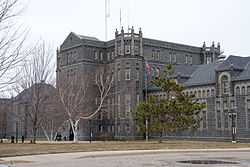Minnesota Correctional Facility – St. Cloud
 | |
| Location | St. Cloud, Minnesota |
|---|---|
| Status | Operational |
| Security class | Close |
| Population | 1,038 (as of September 7, 2011) |
| Opened | 1889 |
| Managed by | Minnesota Department of Corrections |
| Director | Collin Gau, Warden |
|
Minnesota State Reformatory for Men Historic District | |
 | |
| Location | St. Cloud, Minnesota |
|---|---|
| Coordinates | 45°32′35″N 94°7′0″W / 45.54306°N 94.11667°WCoordinates: 45°32′35″N 94°7′0″W / 45.54306°N 94.11667°W |
| Architect | J. Walter Stevens; Clarence H. Johnston |
| Architectural style | Tudor Revival, Romanesque |
| Governing body | State |
| NRHP Reference # |
86001671 [1] |
| Added to NRHP | July 17, 1986 |
Minnesota Correctional Facility – St. Cloud is a state prison located in St. Cloud, Minnesota, United States. Originally built in 1889, it is a level four, close-security institution with an inmate population of about 1,000 men.[2]
MCF-St. Cloud serves as the intake facility for men committed to prison in Minnesota.
History
The prison, originally named the Minnesota State Reformatory for Men, was Minnesota's third prison. The Minnesota Territorial Prison was established in Stillwater in 1853. In 1867, a second institution, the House of Refuge, opened in Saint Paul to house young offenders. The House of Refuge was renamed to the Minnesota State Reform School in 1879, and it moved to Red Wing, Minnesota in 1890. Later, in 1895, it was renamed the Minnesota State Training School. The Minnesota State Reformatory for Men was intended as an intermediate facility between the State Training School and the Territorial Prison. It was created as a reformatory for offenders between sixteen and thirty years old who were presumably salvageable from a life of crime.[3]
The first cell block, a four-story Romanesque Revival structure designed by J. Walter Stevens, was completed in 1889. A second cell block, also designed by Stevens, was built by inmates who quarried granite from an on-site quarry. In 1897, work was started on the Romanesque/Medieval-Style Administration Building. The building was designed by Clarence H. Johnston, who designed several other structures for state institutions. Due to several work stoppages, the Administration Building was not completed until 1920. The building, five stories tall, is built of granite and has a flat roof with octagonal corner towers.[3] The wall was built by prisoners brought over from the Stillwater prison and remains the second largest wall built by prisoners. The quarry that the stone came from is the oldest granite quarry in Minnesota.
Johnston designed other buildings at the Reformatory, including other cell blocks, the north and south dining halls, infirmary, power plant building, maintenance shops, guard towers, and some school and trade buildings. The most imposing structure is the perimeter wall, a 22-foot (6.7 m) high granite wall on the outside perimeter. Historian Denis Gardner writes, "[The granite barrier] all but shouted to those on the outside to be good citizens or else."[3]
License plate stamping was done here for many years until 2008 in which license plates were no longer stamped but Printed and that process was brought to another prison. During the first decades the prison was built, upon release, it was standard to issue you a horse, saddle, rifle, and a gold piece.
References
- ↑ "National Register Information System". National Register of Historic Places. National Park Service. 2007-01-23.
- ↑ "Daily Inmate Profile". Minnesota Department of Corrections. Retrieved 2011-09-07.
- ↑ 3.0 3.1 3.2 Gardner, Denis P. (2004). Minnesota Treasures: Stories Behind the State's Historic Places. St. Paul, Minnesota: Minnesota Historical Society. pp. 183–186. ISBN 0-87351-471-8.
External links
| ||||||||||
| ||||||||||||||||||||||||||